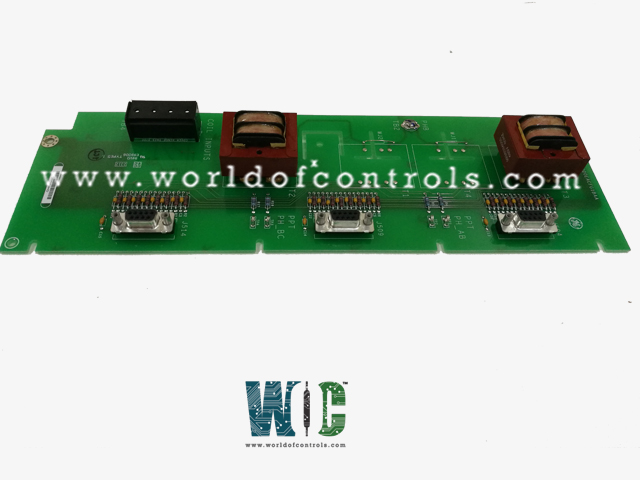SPECIFICATIONS
Part No.: IS200EACFG1BAA
Manufacturer: General Electric
Country of Manufacture: United States of America (USA)
Temperature Operating: -30 to 65oC
Product Type: Exciter AC Feedback Board
Availability: In Stock
Series: EX2100
Functional Description
IS200EACFG1BAA is an Exciter AC Feedback Board developed by GE. It is a part of the EX2100 control system. The Exciter Ac Feedback board (EACF) serves the crucial function of measuring the exciter PPT ac supply voltage and current. Positioned within the exciter auxiliary cabinet, this terminal board ensures optimal performance of the excitation control system.
Features
- The board is designed to measure the three-phase AC voltage from the Exciter PPT. Measure AC current via two flux or air-core current sensors.
- Convert analog signals into conditioned outputs suitable for transmission to EX2100 controllers. This measurement is vital for maintaining voltage regulation, supporting excitation system diagnostics, and enabling protective functions.
- The board is available in two voltage rating options. EACFG1 Up to 480 V RMS Standard low-voltage excitation systems. EACFG2 Up to 1000 V RMS High-voltage excitation applications.
Board Architecture and Components
- Voltage Sensing: The board includes three input transformers for phase-to-neutral voltage sensing. The transformers provide electrical isolation and step down the voltages for safe internal handling.
- Current Sensing: Two terminal points are provided to connect Flux/Air Core current sensors, which are typically used due to their ability to measure large currents without saturation. These sensors feed current signals to the board, where they are conditioned and forwarded to the controller.
- Output Interface: The EACF board outputs its conditioned voltage and current signals through three DB9 connectors. These connectors correspond to the M1, M2, and C control modules (usually redundant controllers in the EX2100 system). The configuration allows for parallel feedback to redundant controllers, ensuring high system availability.
Cabling and Signal Transmission
- The interface between the EACF and the EBKP (Exciter Backplane) is established via shielded cabling.
- The system supports cable lengths of up to 90 meters, which provides flexibility in cabinet layout and remote mounting scenarios.
- Proper shielding and grounding practices are required to mitigate electromagnetic interference (EMI) over long cable runs.
Noise Suppression and Signal Integrity
- The board incorporates filtering and transient protection components to suppress high-frequency noise and protect sensitive electronics.
- Signal conditioning circuits ensure the integrity of the measured values by minimizing drift, offset, and distortion.
- These measures are essential for maintaining measurement accuracy in high-EMI environments, such as power generation facilities.
Integration and Compatibility
- The board is engineered to be fully compatible with the EX2100 excitation system architecture.
- It supports redundant control paths, hot-swapping (in certain configurations), and diagnostics through the ToolboxST software.
- The board is a field-replaceable unit (FRU) and includes status LEDs for basic onboard diagnostics and commissioning checks.
Application Data
- The Exciter Ac Feedback board (EACF) monitors the exciter PPT AC supply voltage and current. Located within the exciter auxiliary cabinet, this terminal board is equipped with transformers for three-phase voltage measurement and provisions for two Flux/Air core coils. The outputs from the voltage and current measurement circuits are dispersed to three DB9 connectors, facilitating cable connections to controllers M1, M2, and C. Notably, the cable length between the EACF and the EBKP backplane board can extend up to 90 meters, offering flexibility in system configuration and placement.
- The board is available in two versions: EACFG1, designed for inputs up to 480 V rms, and EACFG2, accommodating inputs up to 1000 V rms. This distinction allows for compatibility with various excitation system requirements, ensuring optimal performance across different voltage ranges.
- To mitigate high-frequency noise interference, the board features noise suppression mechanisms near the signal entry points, particularly for the Flux/Air core input signals. Additionally, cable shield terminal screws are strategically positioned within three inches of the input screws, where applicable, providing efficient grounding and shielding against external electromagnetic disturbances.
- The layout of the board is depicted in the accompanying figure. Key components include T1 through T4, which represent the three-phase voltage transformers, and individual screw connectors TB1, TB2, and TB3 designated for the voltage inputs. Terminal block TB4 serves as the interface for wiring from the two Flux/Air core coils. Moreover, three 9-pin sub-D connectors, labeled J504, J509, and J514, facilitate cable connections to the EBKP backplane, enabling seamless integration with EMIO boards for comprehensive system functionality and monitoring.
The WOC team is always available to help you with your EX2100 requirements. For more information, please contact WOC.
Frequently Asked Questions
What is IS200EACFG1BAA?
It is an Exciter AC Feedback Board developed by GE under the EX2100 series.
What precautions should I take when disconnecting cables from the board?
Verify that all cables are labeled with the correct connector name as marked on the board to simplify reconnection later. For voltage inputs, carefully disconnect the wiring from screw connectors TB1, TB2, and TB3. For coil inputs, disconnect the wiring at TB4.
What steps should I follow to reconnect cables and wires to the new board?
Reconnect all cables and wires to the board as labeled, ensuring that cables are properly seated at both ends to prevent connectivity issues.
How do I remove the board from its mounting?
Remove the three screws that hold the board to the mounting, and carefully detach the board.
